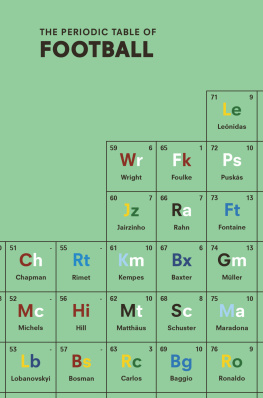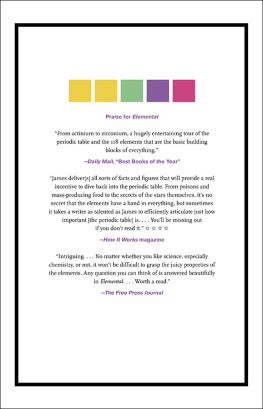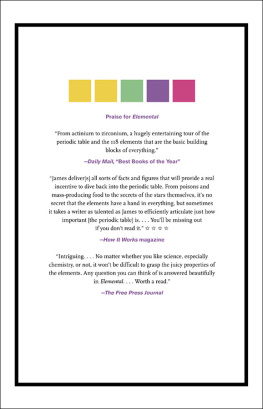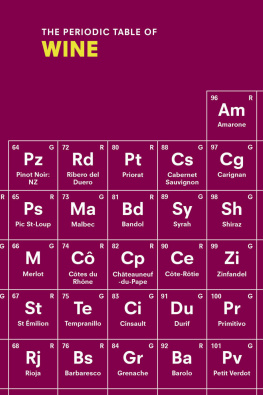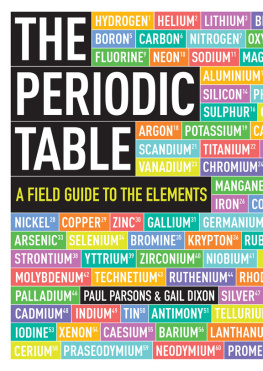Rowlands - The Periodic Table of Wine
Here you can read online Rowlands - The Periodic Table of Wine full text of the book (entire story) in english for free. Download pdf and epub, get meaning, cover and reviews about this ebook. City: New York, year: 2017, publisher: Abrams, genre: Home and family. Description of the work, (preface) as well as reviews are available. Best literature library LitArk.com created for fans of good reading and offers a wide selection of genres:
Romance novel
Science fiction
Adventure
Detective
Science
History
Home and family
Prose
Art
Politics
Computer
Non-fiction
Religion
Business
Children
Humor
Choose a favorite category and find really read worthwhile books. Enjoy immersion in the world of imagination, feel the emotions of the characters or learn something new for yourself, make an fascinating discovery.

- Book:The Periodic Table of Wine
- Author:
- Publisher:Abrams
- Genre:
- Year:2017
- City:New York
- Rating:5 / 5
- Favourites:Add to favourites
- Your mark:
- 100
- 1
- 2
- 3
- 4
- 5
The Periodic Table of Wine: summary, description and annotation
We offer to read an annotation, description, summary or preface (depends on what the author of the book "The Periodic Table of Wine" wrote himself). If you haven't found the necessary information about the book — write in the comments, we will try to find it.
The Periodic Table of Wine — read online for free the complete book (whole text) full work
Below is the text of the book, divided by pages. System saving the place of the last page read, allows you to conveniently read the book "The Periodic Table of Wine" online for free, without having to search again every time where you left off. Put a bookmark, and you can go to the page where you finished reading at any time.
Font size:
Interval:
Bookmark:

You can never take what you love too seriously

The Periodic Table Series
Periodically, were all geeks about the things we love, and the Periodic Table Series has been created to celebrate this universal fact.
Inspired by the Periodic Table of Chemical Elements, our experts have applied scientific logic to an eclectic range of subjects that regularly baffle beginners and fire up fans. The outcome of this experiment is the essential guide you hold in your hand.
Geeky? Absolutely.
Hugely satisfying? Categorically.
The Periodic Table of Chemical Elements orders all the known matter that makes up our world, from hydrogen to helium, by chemical properties and behavior to give scientists a handy overview of a rather complex subject.
Molly,
I love you so much
they havent even invented the maths yet.

Editor: David Cashion
Design Manager: Devin Grosz
Production Manager: Kathleen Gaffney
Library of Congress Control Number: 2016946246
ISBN: 978-1-4197-2408-4
eISBN: 978-1-68335-046-0
Copyright Ebury Press 2015
Illustrations Hennie Haworth 2015
Published in 2017 by Abrams Image, an imprint of ABRAMS. All rights reserved. No portion of this book may be reproduced, stored in a retrieval system, or transmitted in any form or by any means, mechanical, electronic, photocopying, recording, or otherwise, without written permission from the publisher.
Abrams Image books are available at special discounts when purchased in quantity for premiums and promotions as well as fundraising or educational use. Special editions can also be created to specification. For details, contact specialsales@abramsbooks.com or the address below.

ABRAMS The Art of Books
115 West 18th Street, New York, NY 10011
abramsbooks.com

Welcome to The Periodic Table of Wine. The table has been designed to give a visual overview of how different styles of the worlds most popular wines roughly relate to one another. The descriptions later in the book contain more details about the elements of the table.
Dip in and dip out. Use the table practically and get family and friends together to smell and taste wines. Use it as a fun way to gain a deeper understanding of wine attributes, grapes, and regions. See if you agree with the relationships. Where does your wine sit? Open more than one wine at a time by asking your friends to bring a different bottle. Use all your sensessight, smell, and taste, in that orderto notice the differences. Decide which wine you think has the fuller body, or is the fruitiest. Is it spicy or floral, or does it taste greener like herbs, or like minerals such as stones or chalk? Does your wine sit right in the middle of things? Add a rating to indicate how much you liked each wine you tasted and you could find that a pattern emerges, revealing that your favorite style(s) rest in particular areas of the table.
It is not really surprising that there are so many different wines available, but this can make choosing wine confusing. A little like chefs, winemakers all have their own recipes, numerous processes, and various techniques they use in production, from the way the grapes are grown and picked to every step of winemaking. Different grapes grow in different countries too. On top of this, the soil, climate, the vintage (the year a wine was made), and the age of the vines all affect how the final wine in the bottle looks, smells, and tastes. Sometimes even neighboring vineyards make wines with varying characteristics, and each commands a different price.
Knowing what is behind the name on a label is a big help in understanding what the wine in a particular bottle will taste like. For this reason, the table represents a bringing together of the most common names found on wine labels and relates them by their general characteristics (body, flavors, and aromas): hence the style of the wines. The descriptions contain information to clarify what each name means and should help you know what style of wine to expect. This should remove some of the questions and uncertainty you might have about purchasing an unknown wine while increasing your buying confidence, which should lead you on to some delicious new discoveries. So pop a bottle into your shopping basket and start sipping and discovering.
If you know you already like a certain wine, find it in the table, either directly or via the index. The wines closest to it in the table (above, below, left, or right) are similar but have different styles you may also appreciate.
Remember: Wine is not an exact science, so additional wines to try are also suggested in each description. Some are way more adventurous than others, and you might enjoy researching those as well.
Wine elements, at their most basic, can be divided either into grape varieties or appellations; youll find that these are the most common way wines are sold around the world. These label names are key pieces of information that point toward what is in the bottle. Thus a label may show the grape variety that was used to make the wineor varieties, if the bottle contains a blend or mix of more than one grape variety. Look for names like Chardonnay, Cabernet Sauvignon, Sauvignon Blanc, and Merlot. Alternatively, the wine might be labeled using a ).
Not all wines are included, but the wines you are most likely to come across are. While they can influence style, brand names, winemakers, and vintages have not been included in the table, as they cannot always be found locally; plus, they represent an additional layer of detail within or behind a single element or building block of the tablebut they can be explored further by delving within an element to reveal this deeper layer of diversity. Perhaps you would like to conduct your own research by tasting for yourself different wines that fall into one element. The elements of the table have been designed as a starting point for the enjoyment and understanding of wine, by giving a broad overview of how the main wines made around the world relate. The graphic representation is a simplified bringing together of a diverse subject to provide a good foundation upon which your wine knowledge can build.
The columns broadly illustrate how wines vary by the weight or the feel in the mouth when you taste them. This is called body. Full body is heavier, giving a weightier feeling on the palate in the form of big, bold flavors, textures, and tannins (especially in red wines). Full-bodied wines can range from rustic to full of finesse or opulent, if you like. A powerful and elegant wine is a sign of quality, especially if it is also described as having complexity, meaning lots of layers of lingering flavors. Wines that tend to be full-bodied are placed in the outside columns of the table. They are a good match for flavorful dishes. The wines toward the center of the table are lighter-bodied and more delicate on the palateuseful when looking for a neutral-tasting, refreshing drink. This subtler style is popular as an aperitif in hotter weather or sipped on its own, and it pairs well with lighter cuisine because neither overpowers the other.
Next pageFont size:
Interval:
Bookmark:
Similar books «The Periodic Table of Wine»
Look at similar books to The Periodic Table of Wine. We have selected literature similar in name and meaning in the hope of providing readers with more options to find new, interesting, not yet read works.
Discussion, reviews of the book The Periodic Table of Wine and just readers' own opinions. Leave your comments, write what you think about the work, its meaning or the main characters. Specify what exactly you liked and what you didn't like, and why you think so.









